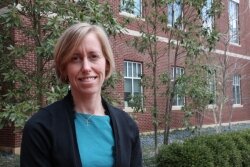Fat secret: Peirce-Cottler seeks cures from saddlebags
One doctor's trash is another's treasure– at least that's the case for UVA biomedical engineer Shayn Peirce-Cottler, whose use of liposuction leftovers in her research is helping improve treatment for serious conditions including diabetes and heart disease. Wait a sec. Love handles as potential life savers? You bet, says Peirce-Cottler, who explains it's not the fat cells themselves that offer such promise, but the stem cells that can be extracted and then injected wherever there's a need for an improved microvascular network– a system of tiny blood vessels that deliver oxygen to cells.
Unlike embryonic stem cells, which are the most versatile– but also the most controversial– fat stem cells have a variety of benefits, says Peirce-Cottler, starting with the fact that there's little to no ethical debate over their use.
They're also more "differentiated," which means they can't turn into just anything. While it limits their medical applications, Peirce-Cottler sees that as a benefit.
"Embryonic stem cells run the risk of becoming anything, including cancer or teratomas," she says. The latter is known to anyone who saw the comedy My Big Fat Greek Wedding as a tumor made up of hair and teeth.
One of the conditions Peirce-Cottler hopes her research will help treat is diabetic retinopathy, which causes blindness.
"If you're moving them into the eye," Peirce-Cottler says of stem cells, "the last thing we'd want to do is create a tumor."
The fat stem cells are particularly suited to boosting vascular regeneration, perhaps unsurprising since, as Peirce-Cottler explains, adipose tissue is the most heavily vascularized tissue in the body.
It was during her post doctoral fellowship at UVA that Peirce-Cottler, 38, discovered the field of fat stem cell research thanks to plastic surgeon Adam Katz, whom she considers her mentor.
"His whole idea was, hey, I'm a plastic surgeon, I do lipo all the time– maybe I should look for stem cells," Peirce-Cottler explains.
Katz left UVA last year, but Peirce-Cottler says she has continued to work with him, and his former UVA plastic surgery department colleagues have stepped in to keep supplying her lab with fat. Her research, of course, has direct implications for their work– particularly in the field of transplants, where increasing blood supply could make a significant difference in whether a transplanted organ, skin graft or even entire face is successful.
The key to research success, she says, is collaboration across departments and disciplines.
"Collaboration is just fun," she says, "but in this day and age with shrinking resources, collaboration is also very prudent. The work you have to do has to be high impact if it's going to get funding. It's higher impact with more stakeholders at the table."

3 comments
If you need a donation, I've got plenty extra for you.
NIce idea, but does it work? Any compelling evidence for it? The Hook should investigate these issues in greater depth; otherwise these articles are just about pleasant but empty cheerleading.
If you want compelling evidence, try doing a google scholar search. You can see abstracts at the very least. Do your own literature search instead of complaining.
P.S. if someone is a doing research at UVA, it's probably govt funded and required plenty of compelling evidence to get ever scarcer grant money.